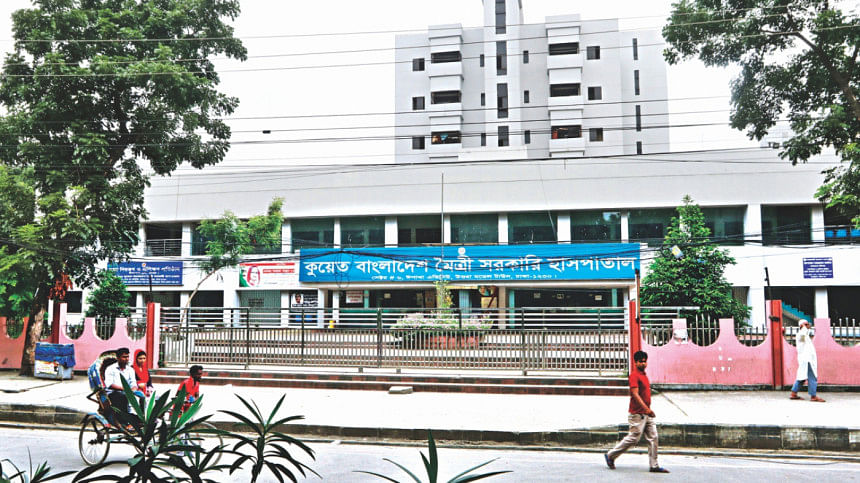Potential unfulfilled in 18 years


The hospital is seven-storied, well-furnished and is the only government facility in a 10-kilometre radius. It does not have the problem most hospitals do -- space shortage. Yet, it has failed to serve residents of Dhaka in 18 years since inauguration.
Kuwait-Bangladesh Friendship Government Hospital, situated near Rajuk Uttara Model College in Sector 6, was inaugurated by Prime Minister Sheikh Hasina in 2001.
In 1992, the Kuwait government and a philanthropist organisation of that country gave $2 million to build the 250-bed facility, especially for the poor. The construction finished in 1996, but the inauguration was pushed back five years apparently due to a legal battle with its construction firm.
A year after opening, the government leased the hospital out to a private organisation, which started running it under the name of American Super Specialised Hospital.
But in the following seven years, the organisation failed to make the hospital fully operational, only running services at a limited scale for outpatients.
In 2009, a newly-formed Awami League government sued the organisation for taking over the government hospital unlawfully, said the hospital’s former director, Prof Dr Md Amirul Hassan. After a six-year court battle, the government won the case and got custody of the hospital in 2015.
The same year, it started running the hospital on its own, still on a small scale, and appointed a few doctors, nurses and employees from the National Tuberculosis Control Programme under the Directorate General of Health Services (DGHS), but failed to launch the hospital to its potential.
In June 2016, the hospital was handed over to Kurmitola General Hospital (KGH).
Brig Gen Aminul Islam, who was then director of KGH and the hospital, said, “When I took over the hospital, it was in a poor state. In my tenure, many doctors and nurses were appointed to the hospital. I also ensured uninterrupted power supply, set up a deep tube-well for drinking water, and built some infrastructure.”
After the better part of two decades since its inception, the hospital finally got its own director in November 2018. One month later, the newly-appointed director, Prof Amirul Hassan, opened indoor services for the first time and decided to admit patients to 100 beds.
However, logistical issues continue to hinder smooth operations. With limited resources, it offers only a few pathological tests like blood and urine tests. The radiology facility -- where X-rays are done -- is in a bad shape, too.
Manpower crisis has always been a feature of the hospital. Most of its rooms remain locked as a result, said Prof Amirul, talking to The Daily Star recently.
“We don’t have the problem of space, while most hospitals in our country have to keep patients on floors and corridors.”
Currently, some 2,200 patients receive treatment at the outdoor services daily, but the indoor services are still limited to 100 beds, he said.
Prof Amirul increased the numbers of doctors and nurses to 63 and 37 respectively, but there is only one administrative officer and one superintendent.
Asked how many employees the hospital needs to run at full capacity, he said there is no final organogram yet, and hence the hospital cannot appoint anyone based on its requirements. “There are a few employees on daily wages.”
Dr Soheli Parvin, one of the two consultants at the radiology department, said, “There is no technician or computer operator at the department. We are having to do their jobs as well.”
Nursing supervisor Shamima Akter said it is difficult to serve so many patients with only 37 nurses in a 100-bed hospital. “It will be harder if all 250 beds open.”
Md Alimuzzaman, the lone administrative officer, said that although the hospital is under the custody of DGHS, it is not financially independent yet.
It does not have a financial code under which the government directly channels funds to a state-run hospital, said Prof Dr Abul Kalam Azad, director general of DGHS. “So, it gets money from Kurmitola General Hospital. Once the hospital has its code, there will be a final organogram and it will receive funds.”
Alimuzzaman said the initial organogram was endorsed by the public administration ministry, but it is awaiting the final approval by the finance ministry.
The organogram would specify how many doctors, nurses and employees the hospital will need and how many wards or departments it will have, he said. “Funding depends on the code but it is not certain when the finance ministry would endorse it.”
Former director Prof Amirul said, “A big fund is required to make the hospital fully functioning. In 2018-2019, this hospital’s allocation came from Kurmitola General Hospital.”
Prof Amirul was replaced by Dr Md Shahjan as the hospital director on June 3.
Asked about his plan, the new director said his focus is on getting the organogram of 218 employees and the financial code approved.
“The doctors and nurses here are working hard, but they are on deputation. Without a permanent workforce, a hospital cannot be made fully operational,” Dr Shahjan said.
Do you have a Dhaka Vibe story to share? Email us your ideas or writeups to [email protected]

 For all latest news, follow The Daily Star's Google News channel.
For all latest news, follow The Daily Star's Google News channel. 



Comments